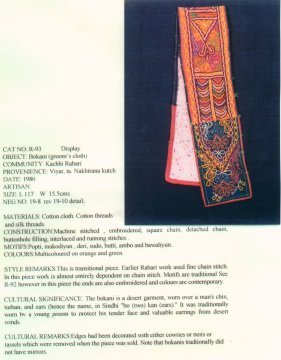|
Description
|
| MATERIALS: Cotton cloth, cotton threads and silk threads. CONSTRUCTION: Machine stitched, embroidered, square chain, detached chain, buttonhole filling, interlaced and running stitches. MOTIFS: Popti, makodiyun, deri, sudo, butti, ambo and bawaliyun. COLOURS : Multicoloured on orange and green. STYLKE REMARKS: This is transitional piece. Earlier Rabari work used fine chain stitch. In this piece work is almost entirely dependent on chain stitch. Motifs are traditional See R-92 however in this piece the ends are also embroidered and colours are contemporary. CULTURAL SIGNIFICANCE: The bokani is a desert garment, worn over a man's chin, turban, and ears (hence the name, in Sindhi ''bo (two) kan (ears).'' It was traditionally worn by a young groom to protect his tender face and valuable earrings from desert winds. CULTURAL REMARKS: Edges had been decorated with either cowries or bells or tassels which were removed when the piece was sold. Note that bokanis tradtionally did not have mirrors. Bokani, Groom's cloth. |
Bokani
-Rabari Arts
-Copyright Statement

COPYRIGHT INFORMATION ~ When using this image, the credit information should be in the following format: Image courtesy of the Kala Raksha Museum.

COPYRIGHT INFORMATION ~ When using this image, the credit information should be in the following format: Image courtesy of the Kala Raksha Museum.